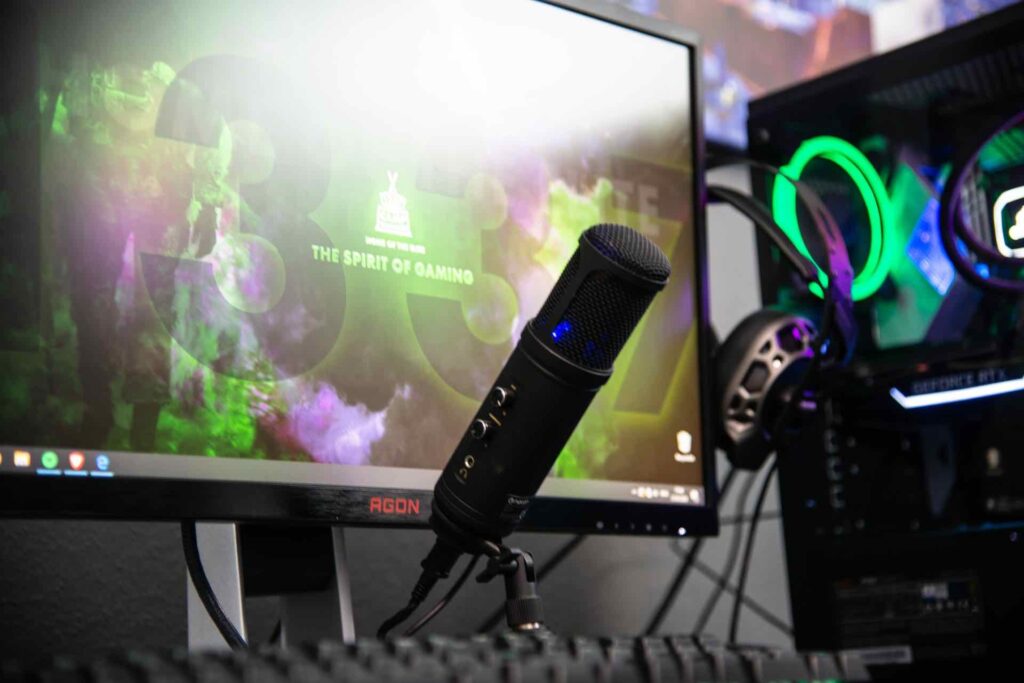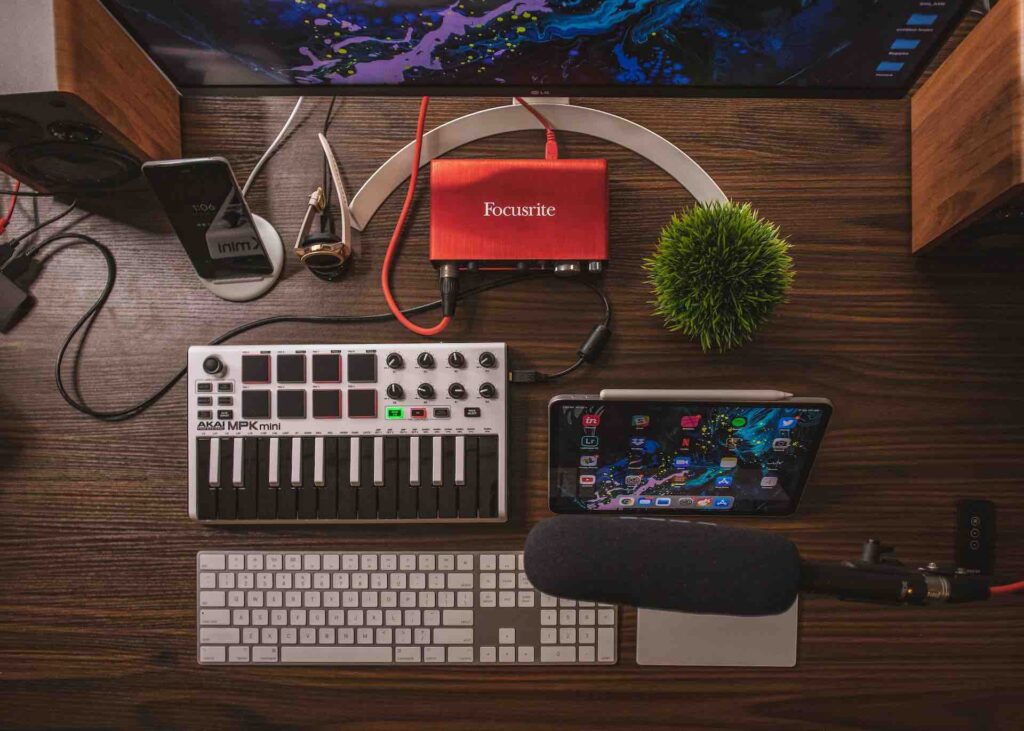Input and output devices often get confused in audio production.
Simply put, a microphone is an input device since it sends data to computers.
Conversely, studio monitors are output devices.
Computers send data to studio monitors to produce sound waves.
Let’s dive deeper into the difference between input and output devices.
We’ll also discuss how microphones work and why they’re input devices.
Key Takeaways
- A microphone is an input device that converts sound waves into electrical signals. A computer or other electronic devices can then process these signals.
- Input devices send data to computers, while output devices receive data from computers.
What is an Input Device?
An input device in audio recording is any device that can send data to a computer.
Your computer receives these data from input devices and stores them as audio files.
By this definition, a microphone, which picks up sound waves and converts them into electrical signals, is an input device.
When microphones produce electrical signals (from sound waves), they send them (when connected) to an analog-to-digital converter (ADC) that converts them into digital signals for your computer.
USB microphones have built-in ADC and can send digital signals to computers directly. But the way to get the cleanest conversion (from analog to digital) is by using a high-quality audio interface as the buffer between an XLR microphone and your computer.
What is an Output Device?
An output device in audio recording is a device that can receive digital information from computers to produce sound waves for playback.
Common output devices in audio recording include loudspeakers, headphones, sound cards, and digital audio converters (DACs).
Output devices are typically located at the end of the signal chain after effects or other signal modifiers have been applied to the digital audio data.
Output devices are an important part of any digital audio recording setup, as they ultimately determine the quality of your playback signal.
Choosing a high-quality output device can help to ensure that recorded audio sounds clear and detailed when you play it back.
Conversely, using a low-quality output device can result in playback that sounds muddy or lackluster.
Output devices can be a significant investment, so it is important to do research to choose the best option for one’s needs.
How Do Microphones Work
A microphone is a transducer that converts sound waves into electrical signals.
Microphones work by converting the energy from sound waves into electrical energy.
When you sing into a mic, its diaphragm reacts when it contacts vibrations from your voice.
These vibrations produce a changing magnetic field which creates electrical energy proportional to a sound wave’s intensity.
Different types of microphones work in different ways, but they all share this basic principle.
For example, dynamic microphones use a moving coil to produce electrical signals, while condenser microphones use a capacitor.
Related Post: Condenser vs. Dynamic Microphone: Complete Guide
USB Microphones

USB microphones are plug-and-play devices.
You can connect one directly to your computer’s USB port without needing an external audio interface.
Their convenience makes them ideal for getting started without investing in extra gear.
But how why can these mics connect directly to your computer while XLR mics need an audio interface?
USB microphones have built-in ADC and mic preamps.
As a result, they can convert analog signals into digital signals internally and send them directly to a computer.
A great all-around USB mic for recording vocals and instruments, gaming, and podcasting is the Blue Yeti.
If you’re looking for a more affordable option, the Audio-Technica AT2005USB is an excellent choice.
But, for those who need a USB microphone for professional recording, the Apogee HypeMic is our top pick.
USB Microphone Downsides
While USB mics are convenient, connecting a mic directly to your computer isn’t the best strategy for the best sound quality. Here are some downsides to using a USB mic:
No XLR Connection
XLR is the standard microphone connection, providing a higher quality signal than a USB connection.
Limited Options for Mic Placement
Because a USB microphone is attached directly to your computer, you’re limited in terms of where you can place the mic for optimal sound quality.
For example, in a home studio setup, it’s often best to position the mic a few feet away from your computer so that any fan noise doesn’t get picked up by the mic.
With a USB mic, however, you’re stuck with whatever position the mic is in when it’s plugged into your computer.
You’re also limited to recording with one mic at a time unless you have a two-channel (or more) audio interface.
Lower Quality Preamps
The preamps in USB mics are often lower quality than standalone preamps, resulting in poorer sound quality.
XLR Mic Connect to an Audio Interface

As mentioned, a microphone converts analog signals (sound waves) into electrical signals.
From there, it sends these electrical signals to an audio interface (when connected).
An audio interface’s ADC converts electrical signals into digital signals for your computer.
Since audio interfaces have specialized converters, they usually produce better sound quality than the converters found in computers and USB mics.
Microphone Preamps
Naturally, microphones output low-level (quiet) signals since their diaphragms react to small vibrations from our voices.
As a result, a microphone needs a preamp to boost its output signal to the proper recording level.
The quality of your mic preamp plays a significant role in the sound quality recordings.
A high gain, low noise mic preamp can boost low-level mic signals to line levels without adding unwanted preamp noise.
Conversely, a low-grade mic preamp can make even the best microphones sound noisy and thin. Your choice of mic preamp is critical to getting great-sounding recordings.
Related Posts:
Top 4 Audio Interfaces with the Best Microphone Preamps
The 6 Best Audio interfaces for the Shure SM7B
Summary: Are Microphones Input or Output Devices?
Input devices in audio recording are the link between the physical and digital worlds.
They take the vibrations of sound in the air and turn them into electrical signals.
These signals are then converted into 1s and 0s so that computers can understand and process them.
There are many different input devices, but the most common input device used in audio recording is a microphone.
Microphones come in all shapes and sizes, but they all serve the same purpose: to convert sound waves into electrical signals.
Microphones work by converting sound waves into electrical signals. When these sound waves hit a microphone’s diaphragm, they cause vibrations. The diaphragm reacts to these vibrations and converts them into electrical signals.
Microphones are the most common input device in audio recording, but there are others, such as guitars and keyboards.
Output devices in audio recording allow you to hear the results of your work.
The most common output devices are speakers and headphones.








